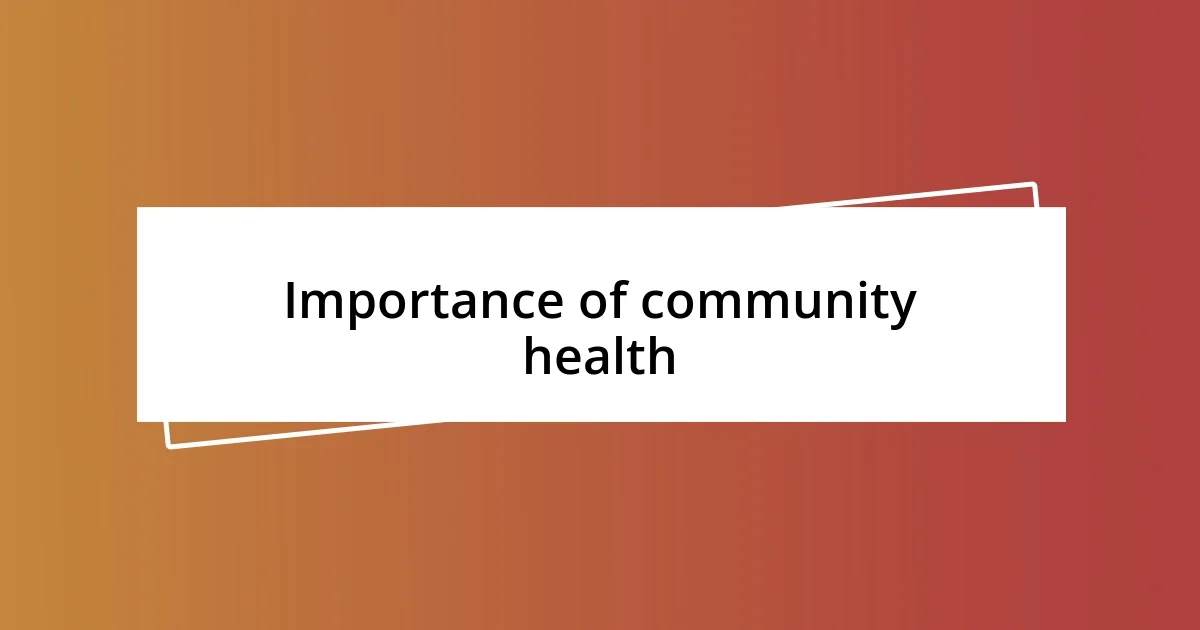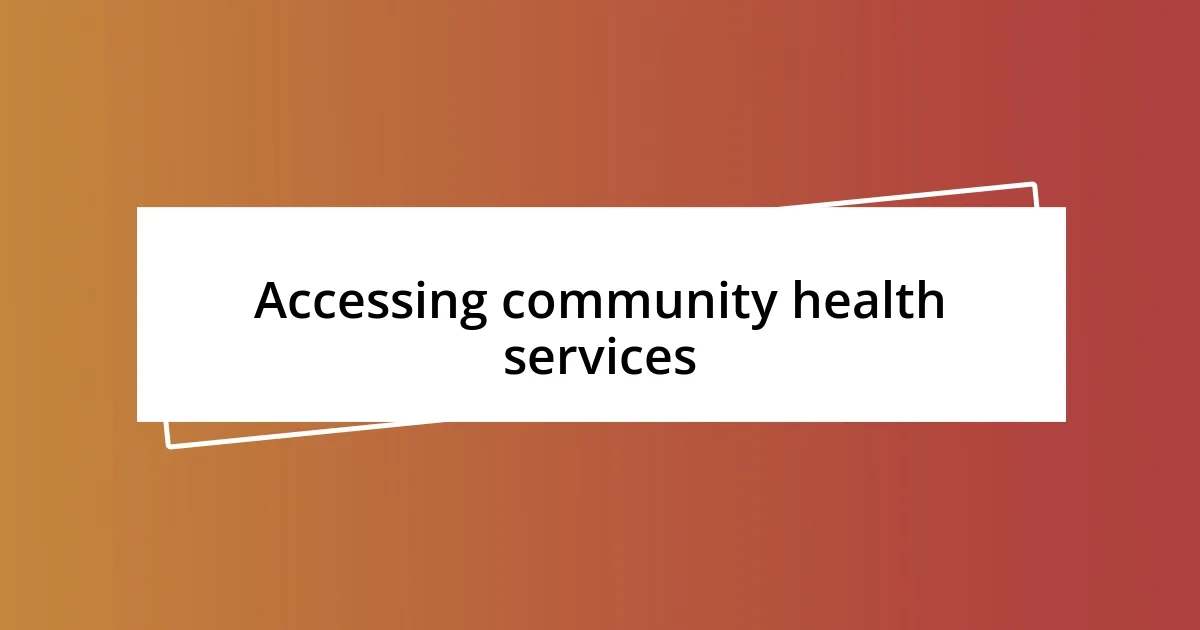Key takeaways:
- Access to community health resources is crucial, but awareness and communication are essential to bridge gaps and ensure people utilize available services.
- Community health fosters social connections, enhances mental well-being, and promotes preventive care, leading to healthier individuals and communities.
- Evaluating health resource effectiveness involves both quantitative measures and qualitative feedback, highlighting the need to listen to diverse community voices for targeted improvements.

Understanding community health resources
Understanding community health resources involves recognizing the various programs and services available to support the well-being of individuals within a community. I remember volunteering at a local health fair and seeing firsthand how access to information and resources can spark hope and empower individuals to take control of their health. Have you ever thought about how much easier it is to seek care when the resources are right there in your neighborhood?
It’s also vital to understand the gaps that sometimes exist in these resources. For instance, I encountered a family that, despite living just a few blocks from a community clinic, had no idea it was even there. This experience made me realize how essential it is to raise awareness about available services and how important communication is in bridging those gaps. What good are resources if people aren’t aware of them?
Moreover, community health resources are not merely about access; they are about building relationships and fostering environments where people feel safe and supported. I recall a community workshop where attendees shared their fears and experiences related to healthcare, and it was incredibly moving to witness the power of shared stories. This rapport can truly elevate the effectiveness of health initiatives, showcasing that healthy communities thrive on connection and support, don’t you think?

Importance of community health
Community health plays a crucial role in shaping the overall wellbeing of individuals and the wider society. When I first joined a local wellness group, I was amazed at how much a supportive community could uplift members. I saw individuals not only improving their health but also forming meaningful connections. This interaction can foster a sense of belonging, which is vital for mental and emotional well-being.
Here are some key points that illustrate the importance of community health:
-
Access to Resources: Community health programs can facilitate access to healthcare, nutrition education, and mental health services.
-
Preventive Care: By promoting awareness of preventive measures, communities can reduce the incidence of chronic diseases.
-
Social Support: Having a network of like-minded individuals encourages healthy behaviors and reduces feelings of isolation.
-
Economic Benefits: Healthy communities often experience lower healthcare costs and increased productivity.
-
Cultural Competence: Community health initiatives often consider cultural nuances, making programs more effective and relatable.
I still recall an elderly neighbor who shared her burden of navigating the healthcare system alone. It was heartwarming to see how community organizations stepped in to guide her, ensuring she received adequate support. Witnessing the joy on her face when she talked about attending support groups was a reminder of the profound impact community health can have on individuals’ lives.

Types of community health resources
Community health resources come in various forms, each uniquely designed to cater to specific needs within a community. For example, health clinics provide essential medical care and preventive services, while educational outreach programs focus on raising awareness about health and wellness. I remember attending a nutrition workshop led by a local dietitian. The knowledge shared didn’t just teach us about food choices; it created a ripple effect, encouraging others to pursue healthier lifestyles.
Another important type of community health resource is mental health support services, which can include counseling, support groups, and crisis intervention. I once participated in a community forum regarding mental health stigma. It was enlightening to hear people’s stories and realize that these resources serve as lifelines for those struggling silently. Having accessible mental health services fosters an environment where individuals feel safe to seek help, don’t you agree?
Finally, community health resources can encompass substance abuse programs, which play a significant role in recovery and rehabilitation. I watched a friend transform through such a program, showcasing how vital these resources are in supporting individuals on their journey to sobriety. The sense of hope I felt in that shared experience helped cement my belief in the power of community health resources across all aspects.
| Type of Resource | Description |
|---|---|
| Health Clinics | Provide medical care and preventive services. |
| Educational Outreach | Focus on health awareness and wellness education. |
| Mental Health Support | Includes counseling, support groups, and crisis intervention. |
| Substance Abuse Programs | Support recovery and rehabilitation efforts. |

Accessing community health services
Accessing community health services can sometimes feel daunting, but I’ve learned that taking that first step is often the hardest part. I remember the day I walked into a local health clinic; I was nervous but quickly realized that the staff was there to help, not judge. Have you ever felt that blend of anticipation and hesitation? It’s completely normal when seeking help, but knowing that these services are designed with care can be comforting.
One remarkable aspect of community health services is their commitment to inclusivity. For instance, language barriers can be a challenge, but many clinics now offer translation services to ensure everyone can communicate their needs effectively. I once attended a workshop where a participant shared her experience overcoming language hurdles to access vital mental health resources. Listening to her story was a powerful reminder that help is available if we seek it out.
Moreover, community health services often provide unique programs tailored to specific needs. I vividly recall a community-sponsored wellness fair that offered everything from screenings to mental health resources. The energy was infectious, as people gathered to learn and connect. It made me wonder: how many opportunities like this do we miss if we don’t actively look for them? Embracing these services can lead to profound changes in our lives and those around us.

Evaluating health resource effectiveness
Evaluating the effectiveness of health resources requires a multifaceted approach. Personally, I’ve found that looking at both quantitative and qualitative outcomes is crucial. For example, when assessing a local support group for mental health, I not only reviewed attendance numbers but also gathered feedback from participants about their experiences and improvements in their well-being. Isn’t it fascinating how one person’s story can reflect the impact of an entire program?
In my experience, one of the more telling indicators of effectiveness is whether resources inspire long-term change. I remember a case where a community nutrition program led to a noticeable increase in healthy eating habits among participants over six months. Hearing attendees share their journey toward healthier lifestyles reinforced the idea that evaluation goes beyond immediate outcomes—it’s about fostering lasting transformation. Don’t you agree that sustainable change is the true marker of success?
Finally, assessing effectiveness also involves recognizing gaps in service. During a recent assessment of local substance abuse programs, I discovered that many individuals felt the need for more targeted outreach, especially for marginalized groups. It made me reflect on the importance of not just measuring success, but also listening to community voices to identify what’s missing. After all, how can we truly claim success without understanding the diverse experiences within our communities?

Strategies for community health improvement
Community health improvement is often about fostering collaboration among local stakeholders. In my experience, engaging community members in meaningful dialogues can reveal their unique needs and strengths. I recall a neighborhood planning meeting where residents shared stories about their health challenges. It was enlightening to witness firsthand how these conversations sparked ideas for initiatives like community gardens and walking groups. Have you ever thought about how pooling local knowledge can breed innovation?
Education plays a pivotal role in community health strategies. I remember attending a workshop on preventive care that not only provided vital information but also empowered participants. People were invited to share their health journeys, which created a sense of camaraderie and trust. When individuals feel informed and supported, they’re more likely to take action towards their well-being. It prompts the question: what if we could harness this empowerment across our communities?
Building partnerships with local organizations is another effective strategy to strengthen community health resources. For example, a collaboration between a local gym and a health clinic resulted in free fitness classes for families. The excitement among participants was palpable; they were not just improving their physical health but also forging connections with their neighbors. It made me wonder: how many more partnerships can we create to expand access and encourage healthy lifestyles? Expanding these networks can create a vibrant ecosystem that nurtures the well-being of everyone involved.














